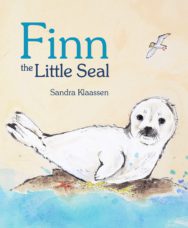‘The little seal looked at the great waves as they crashed on the rocks. The big sea is far too big for me, he thought.’
Following the publication of her new picture book, Finn the Little Seal, we got in touch with illustrator Sandra Klaassen to discuss sources of inspiration, characterisation, her illustration process, and the wild Scottish landscape.
Finn the Little Seal
By Sandra Klaasen
Published by Floris Books
Hi Sandra, thanks for speaking with us today. Could you tell us a bit about yourself and your career so far?
I was born and raised in The Netherlands, and for as long as I can remember I was always busy drawing. According to my mother, I wanted to become a children’s book illustrator from an early age. I would make up my own stories so I could make illustrations for them. My parents supported me in my choice. After graduating from The Royal Academy of Art, I managed to start working as an illustrator, and that was nearly thirty years ago.
Were there any artists or illustrators that really inspired you when you were starting out?
When I started out, I was inspired by several artists, especially at that time Quentin Blake, Tony Ross and William Steig. I was very impressed by their work. Another artist I was (and still am) inspired by is the Dutch illustrator Thé Tjong-Khing. I think his work is outstanding.
What’s your favourite thing about being an illustrator?
My favourite thing about being an illustrator is being inspired by every new story. I literally feel a sparkle inside every time. It’s so exciting to develop ideas for illustrations.
What sort of things do you most enjoy drawing?
I have a preference for illustrating very young children, nature, animals or fairy-like illustrations, but in particular I like to draw attention to emotions and sensitivity. I try to express this in poses and atmosphere. I think this comes from my own character. I cannot draw full, noisy illustrations with a lot happening. I love emptiness and the sound of silence.
Could you walk us through your method for creating your artwork?
Roughly:
I always start with research about my subject. I gather as much information as possible, jot down loads of ideas and keywords and I collect images that might be useful.
I make a storyboard, which helps me plan how the story and illustrations will develop.
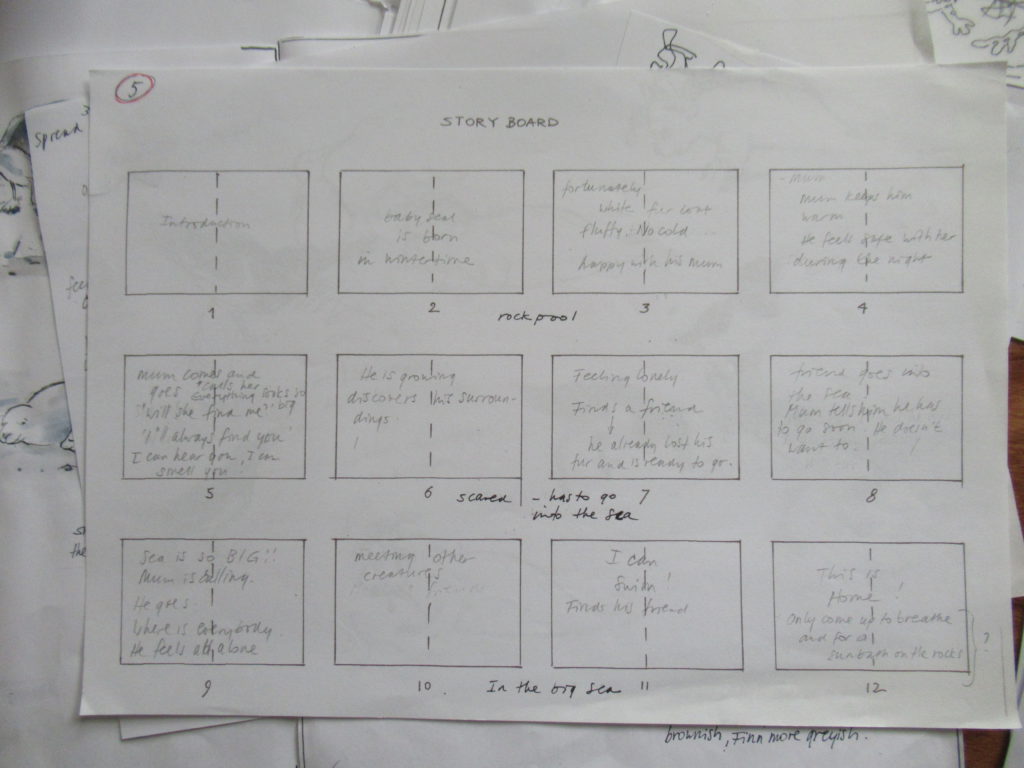
I make sketches and studies of the main character, compositions and other relevant subjects, asking myself ‘what is important to show’? What do I want to emphasize? And (very important) how can I add humour? (For example, the puffin who comes and goes in the background of most of the spreads in Finn the Little Seal). I make my sketches in felt tip because you cannot rub them out, and I work more spontaneously this way. I’m not using any colour yet at this stage.
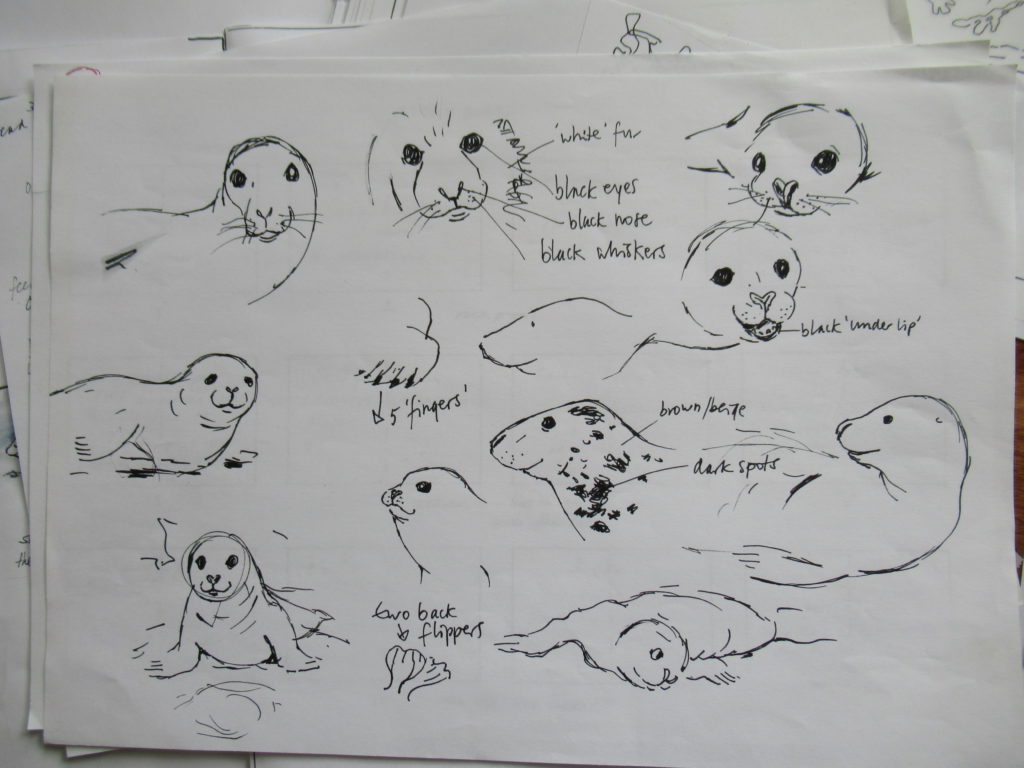
Before creating the final artwork, I make a full-size dummy book with the finished sketches. This lets me experience the work as if it is a finished book and helps to check that everything is well ‘constructed’. I usually end up with a huge pile of paper.
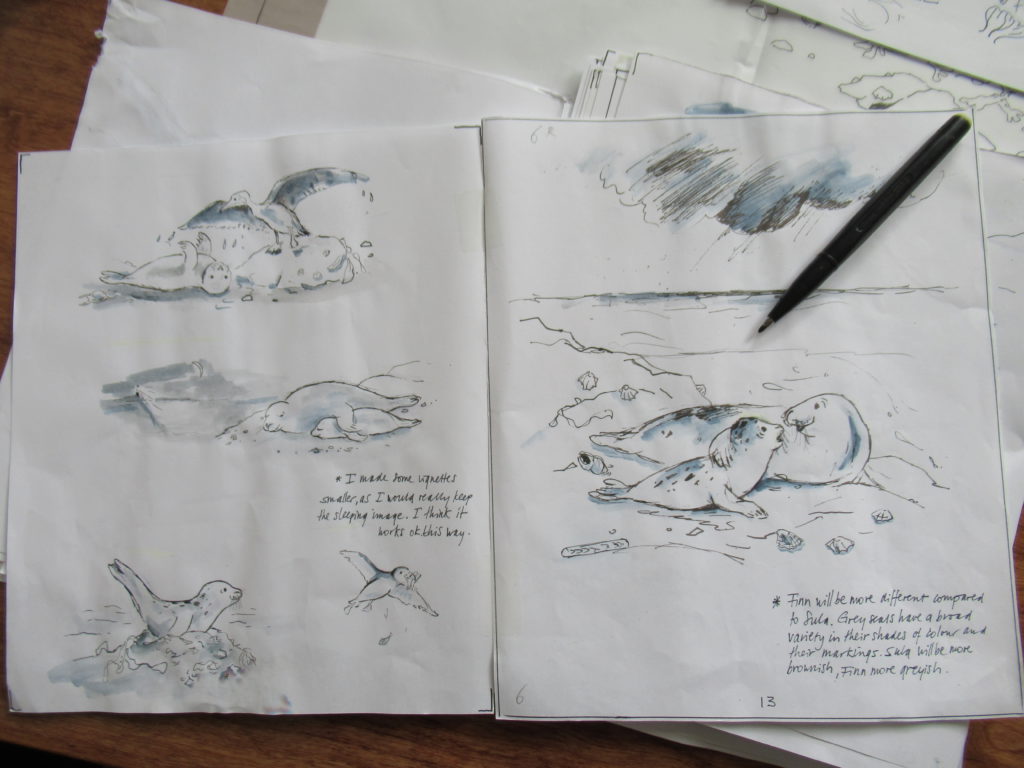
After making copies of all the pages I use my lightbox to transfer the sketches/drawings with pencil onto watercolour paper. I stretch the paper on glass and when dried I can start drawing and colouring the final artwork, using ink, watercolour pencils and watercolour paints.

Can you tell us a bit about your research for Finn the Little Seal?
My research for Finn covers a big part of my own experiences. When I lived on North-Uist we often saw grey seals with their pups in the sea, but also pups all by themselves lying between the rocks. I have loads of photos as well I can draw inspiration from.
Both Peg and Uan (from your previous books) were based on animals you knew, while Finn is a brand-new character. Did this change the way you approached drawing him, compared to the other two?
Drawing Finn was a bit different from drawing Uan and Peg. Uan and Peg were our pets. I cuddled them, held them on my lap, played with them… There was physical contact. I can still smell them and remember how they felt when I stroked them. I knew their characters. With a seal it’s different. You have to observe from a distance and try to get to know a seal’s real character before you can translate it into a children’s book character like Finn.
There is a real sense of motion in your work on this book, particularly in the vignettes of Finn exploring rock pools and later playing in the water – how do you achieve this in your work?
I always try to imagine myself being the character I have to draw. I think it helps to achieve this sense of motion and playfulness. I like the spread with Finn and Sula playing together. They look so happy.
What did you most enjoy about working on this project?
I most enjoyed the process of developing Finn’s character, and the other characters as well, figuring out how to express their emotions through the illustrations.
The Scottish coastal landscape comes across really strongly in your illustrations, do you have a favourite place in Scotland?
I love every place in Scotland; as soon as I touch ground in Scotland, I feel happy. But North Uist is still my favourite place to be. I lived there for many years and I still feel connected with the island and its people. The scenery is so wild and so beautiful, but bleak, harsh and implacable as well. There is water everywhere. The light in winter is absolutely unsurpassed. When there is no wind (not that often…) the reflections of the landscape in the water create a magical, nearly surreal atmosphere. It was here that I experienced what nature really is.
Finn the Little Seal, by Sandra Klaasen is published by Kelpies (an imprint of Floris Books), priced £5.99
ALSO IN THIS ISSUE
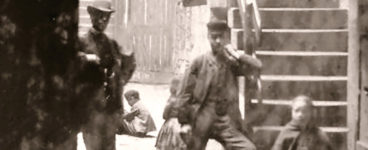
 A Proper Person to be Detained: A Q & A with Catherine Czerkawska
A Proper Person to be Detained: A Q & A with Catherine Czerkawska
‘I’ve always been fascinated by the possibility of giving voices to those who have been ignored thro …
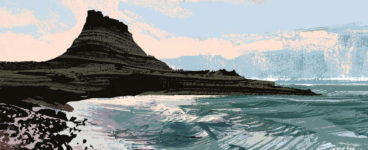
 David Robinson Reviews: Books on Pilgrimages
David Robinson Reviews: Books on Pilgrimages
‘We set out only to come back again, and every departure involves a return until we make the pilgrim …





